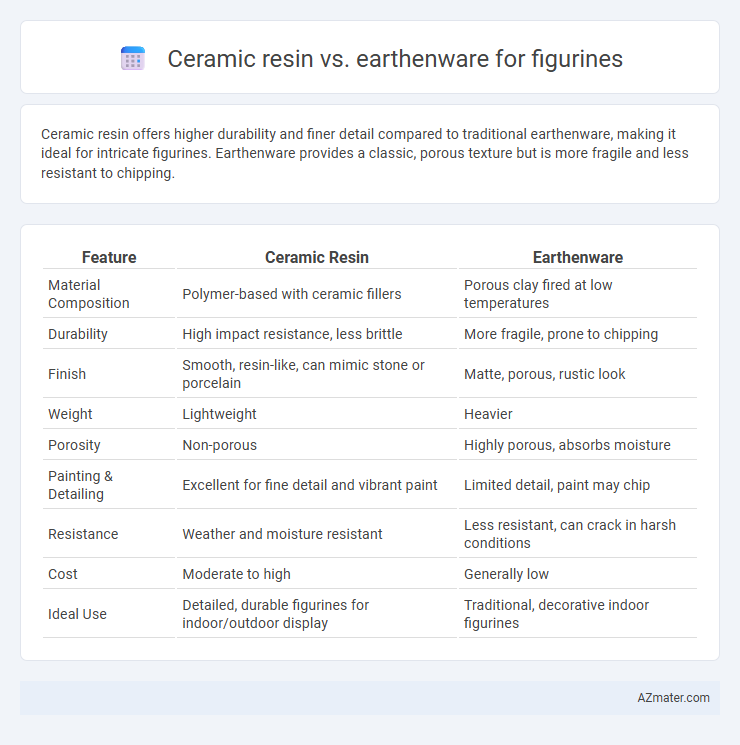Ceramic resin offers higher durability and finer detail compared to traditional earthenware, making it ideal for intricate figurines. Earthenware provides a classic, porous texture but is more fragile and less resistant to chipping.
Table of Comparison
| Feature | Ceramic Resin | Earthenware |
|---|---|---|
| Material Composition | Polymer-based with ceramic fillers | Porous clay fired at low temperatures |
| Durability | High impact resistance, less brittle | More fragile, prone to chipping |
| Finish | Smooth, resin-like, can mimic stone or porcelain | Matte, porous, rustic look |
| Weight | Lightweight | Heavier |
| Porosity | Non-porous | Highly porous, absorbs moisture |
| Painting & Detailing | Excellent for fine detail and vibrant paint | Limited detail, paint may chip |
| Resistance | Weather and moisture resistant | Less resistant, can crack in harsh conditions |
| Cost | Moderate to high | Generally low |
| Ideal Use | Detailed, durable figurines for indoor/outdoor display | Traditional, decorative indoor figurines |
Introduction to Ceramic Resin and Earthenware
Ceramic resin is a durable composite material made from resin combined with ceramic powders, offering high detail and smooth finishes ideal for collectible figurines. Earthenware, a traditional clay-based ceramic fired at lower temperatures, provides a porous and rustic texture that can be glazed for enhanced aesthetic appeal. Both materials differ in strength, finish, and weight, influencing their suitability for different styles of figurine production.
Material Composition and Properties
Ceramic resin, composed of polymer resins combined with fine ceramic powders, offers high durability, lightweight structure, and smooth finish ideal for detailed figurines. Earthenware, made from natural clay fired at lower temperatures, results in a porous, more fragile material with a rustic appearance and heavier weight. The resin's resistance to chipping and water contrasts with earthenware's susceptibility to breakage and moisture absorption, influencing the choice based on desired strength and aesthetic.
Appearance and Surface Finish
Ceramic resin figurines typically showcase a smoother, more polished surface finish with fine detailing and a glossy appearance ideal for vibrant paint applications. Earthenware figurines have a more rustic, matte texture with a porous surface that can result in a slightly rougher feel and a natural, earthy aesthetic. The choice depends on whether a sleek, high-detail look or a traditional, handcrafted appearance is desired for the figurine.
Durability and Strength Comparison
Ceramic resin figurines exhibit higher durability and strength compared to earthenware due to their non-porous structure and resistance to cracking under impact. Earthenware is more porous and prone to chipping or breaking because it is fired at lower temperatures. The density and reinforced composite nature of ceramic resin provide superior resistance to environmental wear, making it ideal for long-lasting figurines.
Detailing and Design Capabilities
Ceramic resin offers superior detailing and design capabilities for figurines due to its fine texture and ability to capture intricate features with high precision, making it ideal for complex and delicate designs. Earthenware, while more porous and less refined, provides a rustic aesthetic but tends to lack the sharpness and smoothness seen in ceramic resin figurines. For artists prioritizing detailed craftsmanship and elaborate decoration, ceramic resin remains the preferred material choice.
Weight and Handling Differences
Ceramic resin figurines are significantly lighter than earthenware, making them easier to handle and move without risk of damage. Earthenware has a denser, heavier composition, providing a sturdier feel but requiring more care during transport to avoid chipping. The lightweight nature of ceramic resin allows for more intricate detailing with less risk of breakage, while earthenware offers a traditional, tactile weight favored in classic craftsmanship.
Painting and Customization Options
Ceramic resin offers a smooth, non-porous surface ideal for detailed and vibrant painting, allowing for fine brushwork and diverse color palettes that enhance figurine customization. Earthenware, with its porous texture, requires sealing before painting, limiting paint absorption but providing a natural, rustic finish preferred for traditional designs. Both materials support customization, yet ceramic resin excels in precision and color durability, while earthenware appeals to artisans seeking a handcrafted, organic aesthetic.
Cost and Accessibility
Ceramic resin figurines typically cost more due to the complex molding process and higher-quality finish, making them a premium choice for collectors. Earthenware, being made from natural clay fired at lower temperatures, is generally more affordable and widely accessible through local artisans and mass production. The availability of earthenware figurines is greater, particularly in regions with rich clay traditions, whereas ceramic resin items often require specialized manufacturing or import.
Suitability for Various Figurine Types
Ceramic resin offers superior detail and durability, making it ideal for intricate figurines such as fantasy characters and collectibles that require fine features. Earthenware, with its porous and heavier nature, suits rustic or traditional figurines and large decorative pieces that benefit from a handcrafted aesthetic. Choosing between ceramic resin and earthenware depends on the desired finish, level of detail, and weight considerations of the figurine type.
Environmental Impact and Sustainability
Ceramic resin figurines generally involve synthetic materials and chemical processes that contribute to higher carbon emissions and limited biodegradability compared to earthenware. Earthenware, made from natural clay fired at lower temperatures, offers greater environmental sustainability through reduced energy consumption and natural material composition. Choosing earthenware supports eco-friendly practices by minimizing chemical waste and promoting recyclable, biodegradable end products in figurine production.

Infographic: Ceramic resin vs Earthenware for Figurine
 azmater.com
azmater.com